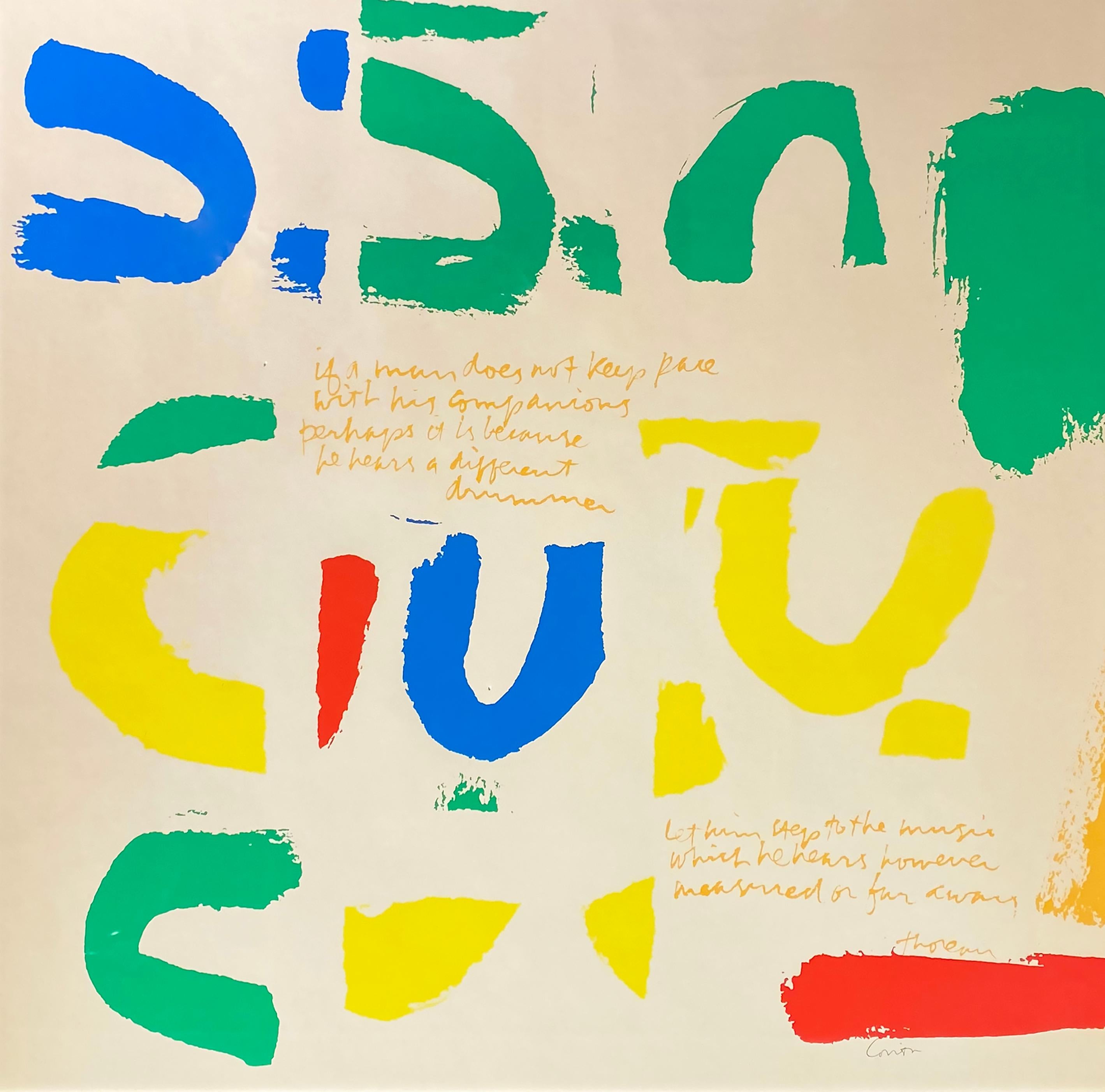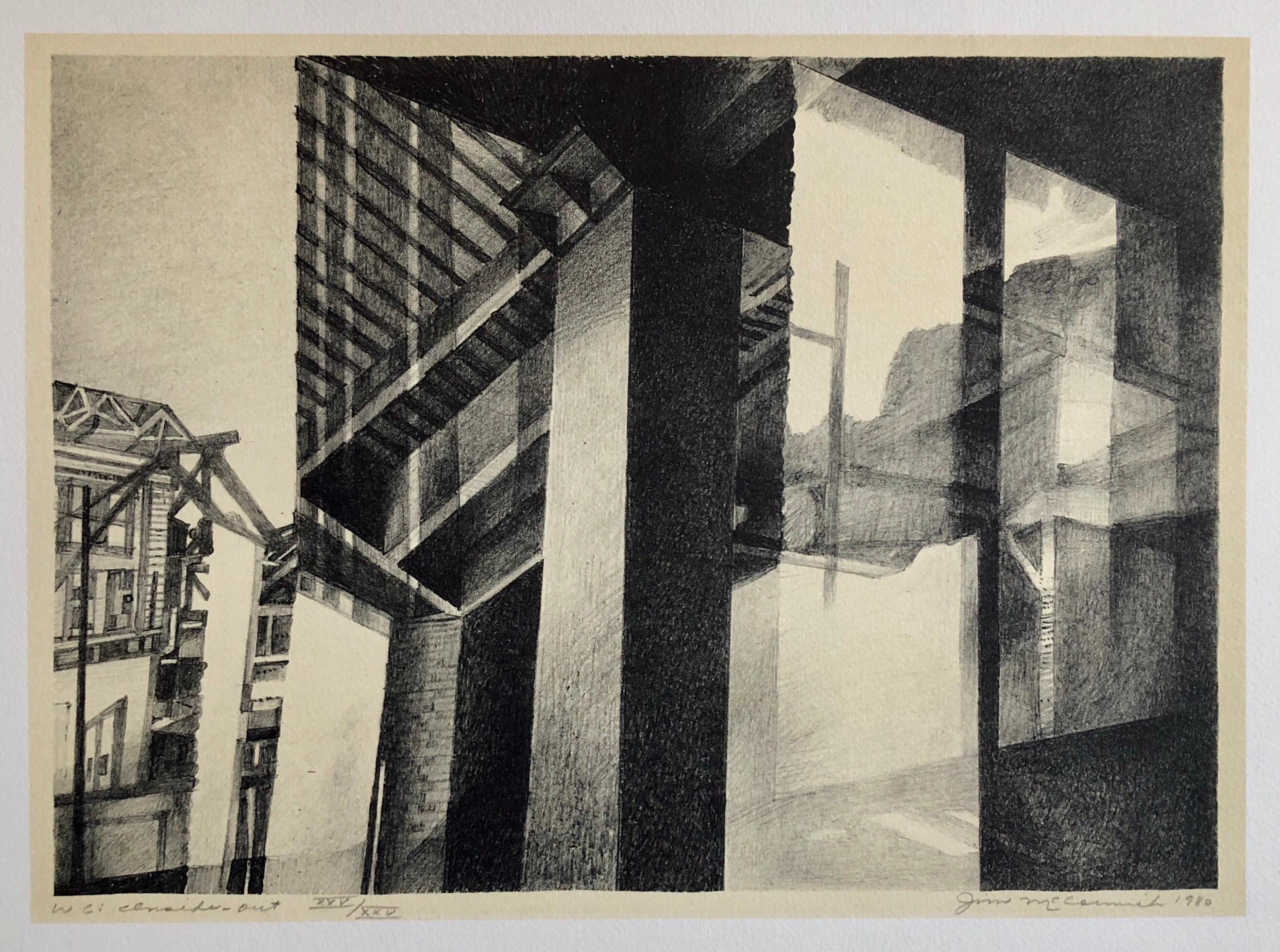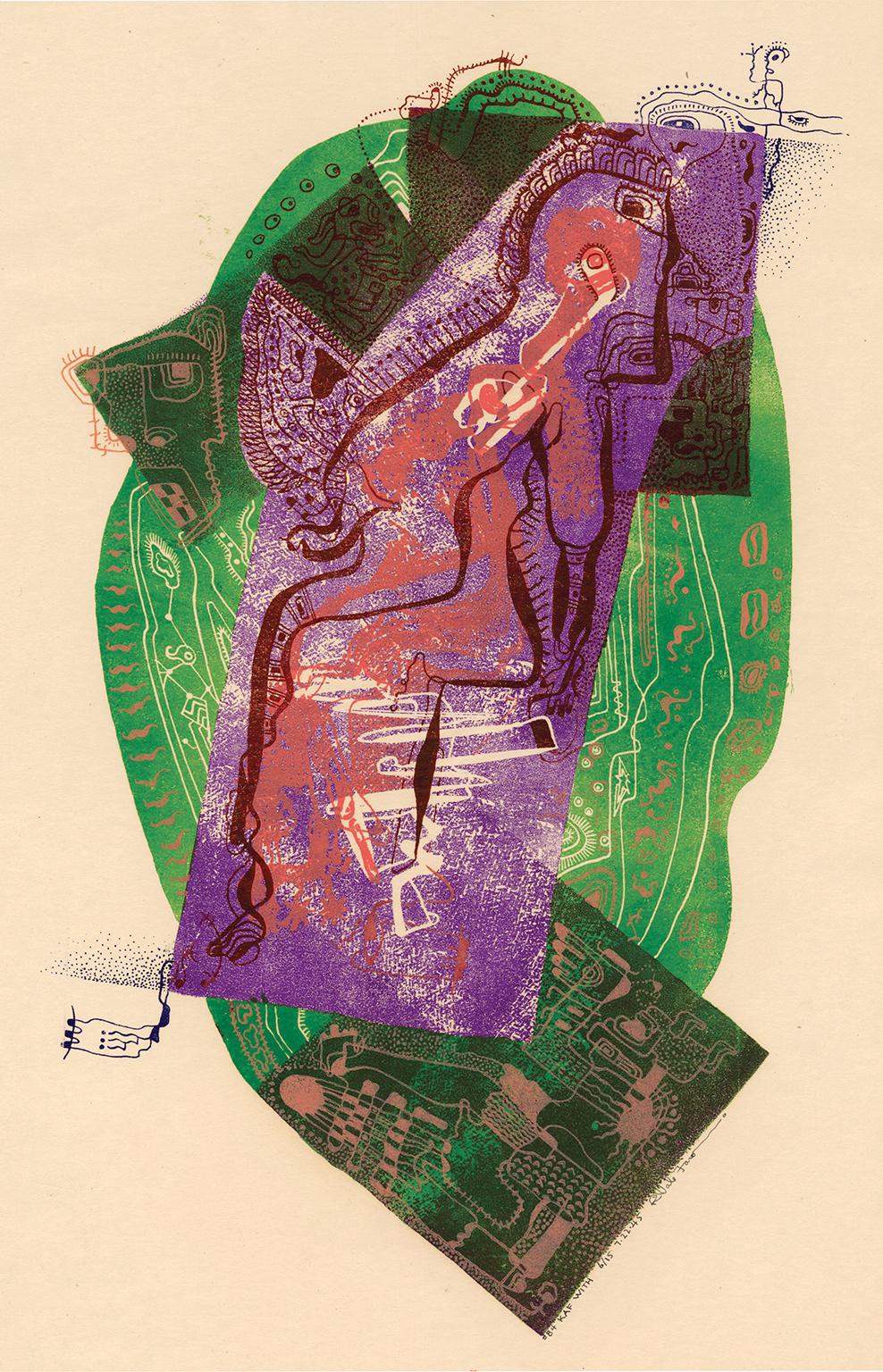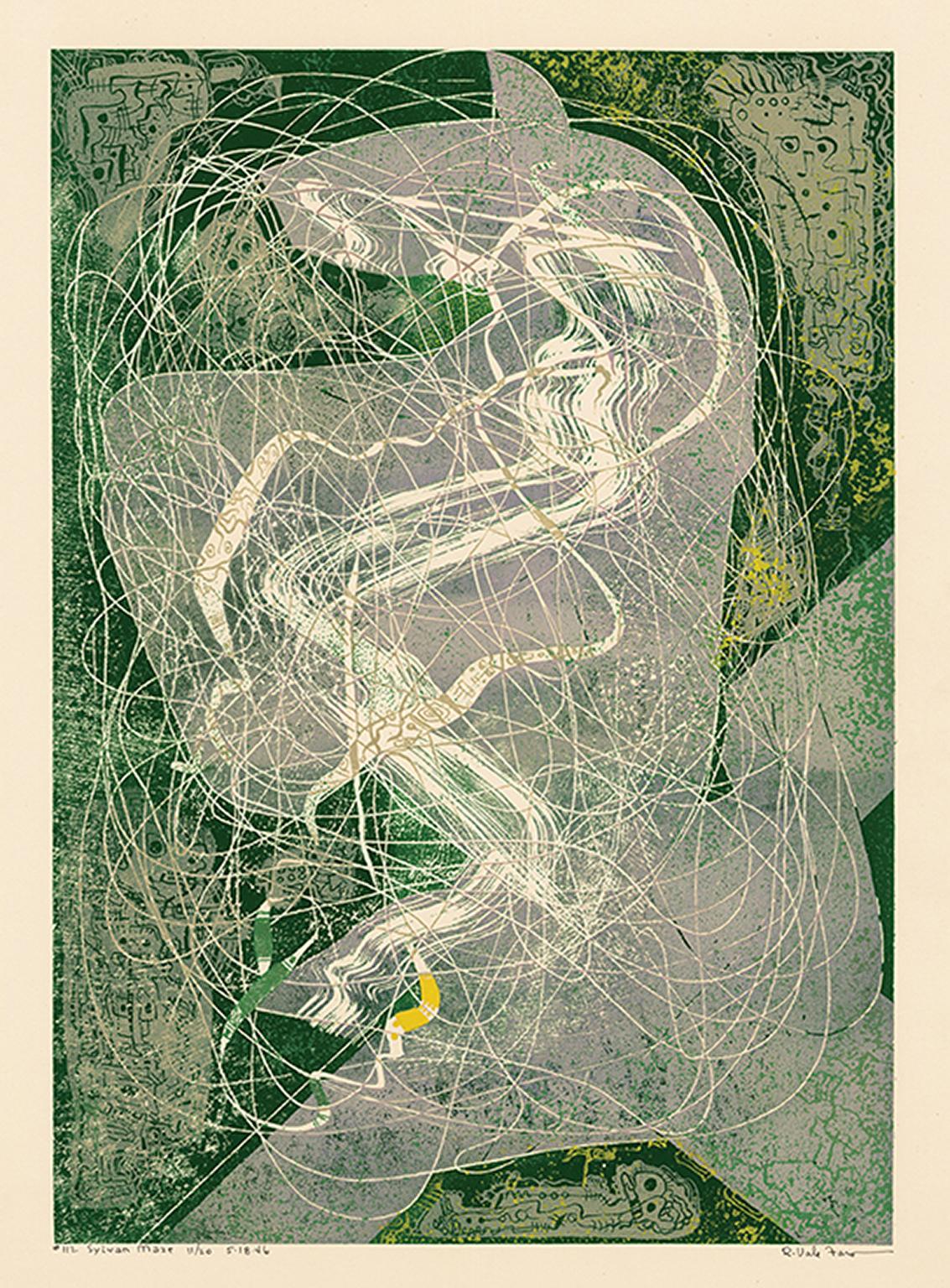Items Similar to Late 20th century color lithograph prairie style Frank Lloyd Wright architecture
Want more images or videos?
Request additional images or videos from the seller
1 of 8
(after) Frank Lloyd WrightLate 20th century color lithograph prairie style Frank Lloyd Wright architecture1984
1984
About the Item
"The Prairie School Collection - Rug" is an offset lithograph poster with gold foil. This piece advertises an exhibition of Frank Lloyd Wright's designs.
34 7/8" x 22" art
36" x 23" framed
Frank Lloyd Wright was born in Richland Center, Wisconsin on June 8, 1867. His parents, William Cary Wright and Anna Lloyd-Jones, originally named him Frank Lincoln Wright, which he later changed after they divorced. When he was twelve years old, Wright's family settled in Madison, Wisconsin where he attended Madison High School. During summers spent on his Uncle James Lloyd Jones' farm in Spring Green, Wisconsin, Wright first began to realize his dream of becoming an architect. In 1885, he left Madison without finishing high school to work for Allan Conover, the Dean of the University of Wisconsin's Engineering department. While at the University, Wright spent two semesters studying civil engineering before moving to Chicago in 1887.
In Chicago, he worked for architect Joseph Lyman Silsbee. Wright drafted the construction of his first building, the Lloyd-Jones family chapel, also known as Unity Chapel. One year later, he went to work for the firm of Adler and Sullivan, directly under Louis Sullivan. Wright adapted Sullivan's maxim "Form Follows Function" to his own revised theory of "Form and Function Are One." It was Sullivan's belief that American Architecture should be based on American function, not European traditions, a theory which Wright later developed further. Throughout his life, Wright acknowledged very few influences but credits Sullivan as a primary influence on his career. While working for Sullivan, Wright met and fell in love with Catherine Tobin. The two moved to Oak Park, Illinois and built a home where they eventually raised their five children. In 1893, Sullivan and Wright ended their business relationship. Wright opened his own firm in Chicago, which he operated there for five years before transferring the practice to his home in Oak Park.
Wright's early houses revealed a unique talent in the young, aspiring architect. They had a style all their own, mimicking that of a horizontal plane, with no basements or attics. Built with natural materials and never painted, Wright utilized low-pitched rooflines with deep overhangs and uninterrupted walls of windows to merge the horizontal homes into their environments. He added large stone or brick fireplaces in the homes' heart, and made the rooms open to one another. His simplistic houses served as an inspiration to the Prairie School, a name given to a group of architects whose style was indigenous of midwestern architecture. Later he became one of its chief practitioners. Some of his most notable creations include the Robie House in Chicago, Illinois and the Martin House in Buffalo, New York.
In 1909, after eighteen years in Oak Park, Wright left his home to move to Germany with a woman named Mamah Borthwick Cheney. When they returned in 1911, they moved to Spring Green, Wisconsin where his mother had given him a portion of his ancestors' land; it was the same farm where he had spent much time as a young boy. In Spring Green he constructed Taliesin. They lived there until 1914 when tragedy struck. An insane servant tragically murdered Cheney and six others, then set fire to Taliesin. Many people thought this horrific event would be the end of Wright's career. He proved them wrong however, with his decision to rebuild Taliesin.
Over the next 20 years Wright's influence continued to grow in popularity in the United States and Europe. Eventually his innovative building style spread overseas. In 1915, Wright was commissioned to design the Imperial Hotel in Tokyo. It was during this time that Wright began to develop and refine his architectural and sociological philosophies. Because Wright disliked the urban environment, his buildings also developed a style quite different from other architects of the time. He utilized natural materials, skylights and walls of windows to embrace the natural environment. He built skyscrapers that mimicked trees, with a central trunk and many branches projecting outward. He proclaimed that shapes found in the environment should be not only integrated, but should become the basis of American architecture. A great example is the Larkin Company Administration Building in Buffalo, New York (1903), and the Guggenheim Museum in New York City (1943), which resembles the structure of a shell or a snail.
In 1932, Wright opened Taliesin up as an architectural fellowship where young students could pay to work with and learn from him. Thirty apprentices came to live with him at Taliesin. Through the Taliesin Fellowship, Wright created masterpieces such as Fallingwater (the Kaufmann House) in Mill Run, Pennsylvania, and the SC Johnson and Son Wax Company Administration Center in Racine, Wisconsin. During this time, he married and separated from Miriam Noel and met his third wife, Olivanna Milanoff. The two lived happily at Taliesin for five years and raised a child there. As the couple grew older, the Wisconsin winters became too much for them. In 1937, Wright moved his family and fellowship to Phoenix, Arizona where he built Taliesin West and spent the last twenty years of his life.
At Taliesin West, because of the comfortable year-round climate, Wright was able to integrate the outdoors with his indoor spaces. He designed high sloping roofs, translucent ceilings, and large, open doors and windows that created a subtle distinction between the home and the environment. Both Taliesin and Taliesin West were continuous living experiences for Wright as they constantly remained under construction. As his fellowship grew and the need for a larger facility became necessary, Wright continued to create additions and expansions on both homes.
On April 9, 1959 at age ninety-two, Wright died at his home in Phoenix, Arizona. By the time of his death, he had become internationally recognized for his innovative building style and contemporary designs. He had created 1,141 designs, of which 532 were completed. His name had become synonymous with great design, not only because of the form of his designs, but also because of the function. In the end, he showed not just what to live in, but more importantly he influenced the very nature of how we lived.
- Creator:
- Creation Year:1984
- Dimensions:Height: 36 in (91.44 cm)Width: 23 in (58.42 cm)
- Medium:
- Movement & Style:
- Period:
- Condition:
- Gallery Location:Milwaukee, WI
- Reference Number:
About the Seller
4.9
Platinum Seller
These expertly vetted sellers are 1stDibs' most experienced sellers and are rated highest by our customers.
Established in 1966
1stDibs seller since 2017
393 sales on 1stDibs
Typical response time: 2 hours
- ShippingRetrieving quote...Ships From: Milwaukee, WI
- Return PolicyA return for this item may be initiated within 14 days of delivery.
More From This SellerView All
- 'Winter Silhouettes, ' offset lithograph by Schomer LichtnerBy Schomer LichtnerLocated in Milwaukee, WI'Winter Silhouettes,' a small and delicate print, is an original offset lithograph by the Milwaukee artist Schomer Lichtner. The composition displays registers of foliage, emerging f...Category
1960s American Modern Landscape Prints
MaterialsBlack and White, Lithograph
- 'Winter Silhouettes, ' offset lithograph by Schomer LichtnerBy Schomer LichtnerLocated in Milwaukee, WI'Winter Silhouettes,' a small and delicate print, is an original offset lithograph by the Milwaukee artist Schomer Lichtner. The composition displays registers of foliage, emerging from the white of the paper as though emerging from the snow-covered ground. The artwork is thus plays with the materials of printmaking; the paper is both the support and the primary indication of the season. The subtle texture of the tooth of the paper also adds life to the image, giving the snow a wind-swept, creature trodden surface. The free forms of the grasses and leaves resemble the lyrical mid-century works of the French artist Henri Matisse, which combined with these material concerns demonstrate Lichter's modern sensibilities. 3.75 x 2.75 inches, image 5.5 x 4.5 inches, paper 10 x 8 inches frame Signed and dated in the stone, lower right Framed to conservation standards in a shadow-box style mounting, using 100 percent rag matting, museum glass, and housed in a cherry wood moulding Overall excellent condition; some toning to edges of paper; some minor abrasions to frame Milwaukee artist Schomer Lichtner was well known for his whimsical cows and ballerinas and abstract imagery. He and his late wife Ruth Grotenrath, both well-known Wisconsin artists, began their prolific careers as muralists for WPA projects, primarily post offices. Lichtner also painted murals for industry and private clients. Schomer was a printmaker and produced block prints, lithographs, and serigraph prints. His casein (paint made from dairy products) and acrylic paintings are of the rural Wisconsin landscape and farm animals. He became interested in cows when he and Ruth spent summers near Holy Hill in Washington County. According to David Gordon, director of the Milwaukee Art Museum, Schomer Lichtner had a tremendous joie de vivre and expressed it in his art. Schomer Lichtner was nationally known for his whimsical paintings and sculptures of black- and white-patterned Holstein cows and elegant ballerina dancers. Lichtner also painted all sorts of combinations of beautiful women, flowers and country landscapes. James Auer, former Milwaukee Journal Sentinel art critic, said that his art eventually "exploded into expressionistic design elements with bold, flat areas of color and high energy that anticipated Pop Art." Auer went on to describe Lichtner’s work as full of "wit, vigor and virtuosity." As early as 1930, Lichtner’s work was shown at the prestigious Carnegie International Exhibition in New York and at museums throughout the Midwest. As a student, he was a protégé of another icon of 20th century American art, Gustave Moeller. Lichtner and his wife, Ruth Grotenrath (1912-1988), are celebrated as Milwaukee’s first couple of painting and are regarded as major Wisconsin artists. Lichtner’s impressive production, perseverance, longevity, and positive approach to his life and art made him and his work distinctive and much loved by his many admirers. His work is currently represented in collections at the Milwaukee Art Museum, the John Michael Kohler Art Center, the West Bend Museum, and in the collections of many individuals. Books on the lives and art work of both Lichtner and Grotenrath are in progress and it is anticipated that they will be published next year. Schomer Lichtner passed away on May 9, 2006 at the age of 101. He continued to amaze and create with his whimsical paintings of ballerinas...Category
1960s American Modern Landscape Prints
MaterialsBlack and White, Lithograph
- 'Flowers' original abstract linocut by Wisconsin artist Schomer LichtnerBy Schomer LichtnerLocated in Milwaukee, WI'Flowers' is an original linocut by Wisconsin-based artist Schomer Lichtner. The composition presents a scattered floral still life amongst abstracted shadows and forms, rendered with Lichtner's quintessential abstract sensibilities. This print is one from a series that each depict abstracted subjects in black silhouette, taking pleasure in the materiality of the linocut technique. The free forms of the flower resemble the lyrical mid-century works of the French artist Henri Matisse, which combined with these material concerns demonstrate Lichter's modern sensibilities. The prints from this series are unusual because of how below the image, Lichtner also includes his Chinese seal and a linocut remarque of a cow, each of which act as an additional signature of the artist on the artwork. Linocut in black and red on Permalife white wove paper 4 x 5.25 inches, image 11.5 x 8.75 inches, sheet 16.5 x 13.63 inches, frame Signed in pencil, below image, lower right. Edition 1/100 in pencil, below image, lower left. Chinese signature stamp in red, below image, lower right. Remaque of a cow in red, below image, lower right. Permalife watermark to paper. Framed to conservation standards in a shadow-box style mounting, using 100 percent rag matting, museum glass, and housed in a silver-finish wood moulding. Overall excellent condition with no creases or discoloration. Milwaukee artist Schomer Lichtner was well known for his whimsical cows and ballerinas and abstract imagery. He and his late wife Ruth Grotenrath, both well-known Wisconsin artists, began their prolific careers as muralists for WPA projects, primarily post offices. Lichtner also painted murals for industry and private clients. Schomer was a printmaker and produced block prints, lithographs, and serigraph prints. His casein (paint made from dairy products) and acrylic paintings are of the rural Wisconsin landscape and farm animals. He became interested in cows when he and Ruth spent summers near Holy Hill in Washington County. According to David Gordon, director of the Milwaukee Art Museum, Schomer Lichtner had a tremendous joie de vivre and expressed it in his art. Schomer Lichtner was nationally known for his whimsical paintings and sculptures of black- and white-patterned Holstein cows...Category
Late 20th Century American Modern Abstract Prints
MaterialsPaper, Black and White, Linocut
- 'Field' original abstract linocut in black by Wisconsin artist Schomer LichtnerBy Schomer LichtnerLocated in Milwaukee, WI'Field' is an original linocut by Wisconsin-based artist Schomer Lichtner. The composition presents fields of flowers, trees and grasses below a cloudy sky, but rendered with Lichtner's quintessential abstract sensibilities. This print is one from a series that each depict abstracted subjects in black silhouette, taking pleasure in the materiality of the linocut technique. The free forms of the plants resemble the lyrical mid-century works of the French artist Henri Matisse, which combined with these material concerns demonstrate Lichter's modern sensibilities. The prints from this series are unusual because of how below the image, Lichtner also includes his Chinese seal and a linocut remarque of a cow, each of which act as an additional signature of the artist on the artwork. Linocut in black and red on Permalife white wove paper 4.5 x 6 inches, image 11.5 x 8.75 inches, sheet 16.5 x 13.63 inches, frame Signed in pencil, below image, lower right. Edition 1/100 in pencil, below image, lower left. Chinese signature stamp in red, below image, lower right. Remaque of a cow in red, below image, lower right. Permalife watermark to paper. Framed to conservation standards in a shadow-box style mounting, using 100 percent rag matting, museum glass, and housed in a silver-finish wood moulding. Overall excellent condition with no creases or discoloration. Milwaukee artist Schomer Lichtner was well known for his whimsical cows and ballerinas and abstract imagery. He and his late wife Ruth Grotenrath, both well-known Wisconsin artists, began their prolific careers as muralists for WPA projects, primarily post offices. Lichtner also painted murals for industry and private clients. Schomer was a printmaker and produced block prints, lithographs, and serigraph prints. His casein (paint made from dairy products) and acrylic paintings are of the rural Wisconsin landscape and farm animals. He became interested in cows when he and Ruth spent summers near Holy Hill in Washington County. According to David Gordon, director of the Milwaukee Art Museum, Schomer Lichtner had a tremendous joie de vivre and expressed it in his art. Schomer Lichtner was nationally known for his whimsical paintings and sculptures of black- and white-patterned Holstein cows...Category
Late 20th Century American Modern Landscape Prints
MaterialsBlack and White, Paper, Linocut
- "Season's Greetings, " Abstract Holiday Silkscreen signed by Schomer LichtnerBy Schomer LichtnerLocated in Milwaukee, WI"Season's Greetings" is an original color silkscreen by Schomer Lichtner. The artist signed the piece in the screen on verso. This piece features abstract, linear patterns in blue and white on a brown paper background. 6 1/4" x 4 5/8" art 14" x 12 1/2" frame Milwaukee artist, Schomer Lichtner passed away on May 9, 2006 at the age of 101. He continued to amaze and create with his whimsical paintings of ballerinas and cows. He and his late wife Ruth Grotenrath, both well-known Wisconsin artists, began their prolific careers as muralists for WPA projects, primarily post offices. Schomer Lichtner was well known for his whimsical cows and ballerinas, such as his "Ballerina Dancing on Cow" sculpture below. The late James Auer, art critic for the Milwaukee Journal Sentinel referred to Lichtner as the artist laureate of Milwaukee, Wisconsin. He was the official artist of the Milwaukee Ballet. Lichtner also painted murals for industry and private clients. Schomer was a printmaker and produced block prints, lithographs, and serigraph prints. His casein (paint made from dairy products) and acrylic paintings are of the rural Wisconsin landscape and farm animals. He became interested in cows when he and Ruth spent summers near Holy Hill in Washington County. According to David Gordon, director of the Milwaukee Art Museum, Schomer Lichtner had a tremendous joie de vivre, " joy of life," and expressed it in his art. Schomer Lichtner was nationally known for his whimsical paintings and sculptures of black- and white-patterned Holstein cows and elegant ballerina dancers. Lichtner also painted all sorts of combinations of beautiful women, flowers and country landscapes. James Auer, former Milwaukee Journal Sentinel art critic, said that his art eventually "exploded into expressionistic design elements with bold, flat areas of color and high energy that anticipated Pop Art." Auer went on to describe Lichtner’s work as full of "wit, vigor and virtuosity." As early as 1930, Lichtner’s work was shown at the prestigious Carnegie International Exhibition in New York and at museums throughout the Midwest. As a student, he was a protégé of another icon of 20th century American art, Gustave Moeller...Category
1950s American Modern Abstract Prints
MaterialsScreen
- Pour Daniel-Henry Kahnweiler Figure in LandscapeBy Yves RouvreLocated in Milwaukee, WI"Pour Daniel-Henry Kahnweiler Figure in Landscape" is an original lithograph by Yves Rouvre. The artist signed the piece lower right. It features an abstracted figure in fields of co...Category
1960s Modern Figurative Prints
MaterialsLithograph
You May Also Like
- Douglas Semivan Abstract Modern "Receiver I" Signed and NumberedBy Douglas SemivanLocated in Detroit, MISALE ONE WEEK ONLY "Receiver I" is an abstract print of three diagonally placed lines. It is reminiscent of an early work by Georgia O'Keeffe, "Blue Lines X" in that both artists, Semivan and O'Keeffe, have achieved a beauty in the placement, width of, length and juxtapositions of simple lines to achieve a never ending balance and harmony for the viewer. Born in Detroit, Michigan, Douglas Semivan...Category
Late 20th Century American Modern Abstract Prints
MaterialsPaper, Lithograph
- Leo Baeck "and a Spirit is Characterized"By Corita KentLocated in Missouri, MOLeo Baeck and a Spirit is Characterized Sister Mary Corita Kent (American, 1918-1986) Signed Lower Right in Pencil Edition of 250 Lower center 21.5 x 21.5 inches 24 x 24 inches frame...Category
20th Century American Modern Abstract Prints
MaterialsColor, Lithograph
- Thoreau "If a Man Does Not Keep Peace"By Corita KentLocated in Missouri, MOThoreau "If a Man Does Not Keep Peace" Sister Mary Corita Kent (American, 1918-1986) Signed in Pencil Lower Right 22.5 x 22.5 inches 23.25 x 23.25 inches with frame Sister Mary Cori...Category
20th Century American Modern Abstract Prints
MaterialsColor, Lithograph
- Chicago Scene Modernist Architectural Lithograph, Nevada ArtistLocated in Surfside, FLJim McCormick was born in Chicago in 1936. He attended the University of Tulsa where he received a bachelor’s degree in art in 1958, then a M.A. in paint...Category
1980s American Modern Abstract Prints
MaterialsLithograph
- 'Kaf With' — Mid-century American SurrealismBy Robert Vale FaroLocated in Myrtle Beach, SCRobert Vale Faro, 'Kaf With', color lithograph, 1945, edition 15. Signed, dated, titled and numbered '84' and '6/15' in pen, recto. Titled, numbered '#84' and '6/15' and dated '7/22/...Category
1940s American Modern Abstract Prints
MaterialsLithograph
- 'Sylvan Maze' — Mid-century American SurrealismBy Robert Vale FaroLocated in Myrtle Beach, SCRobert Vale Faro, 'Sylvan Maze', color lithograph, 1946, edition 20. Signed, dated, titled and numbered '112' and '11/20' in pencil. A fine, richly-inked impression with fresh colors, on heavy, off-white wove paper; full margins (1 to 1 1/2 inch), in excellent condition. Image size 13 11/16 x 9 11/16 inches; sheet size 16 1/8 x 12 5/16 inches. Scarce. Matted to museum standards, unframed. ABOUT THE ARTIST Robert Vale Faro (1902-1988) was a modernist architect and artist associated with the Chicago Bauhaus. He received his degree in architecture and design from the Armour Institute in Chicago and worked at L'Ecole des Beaux-Arts, Paris, from 1924-27, where he was influenced by Harry Kurt Bieg and Le Corbusier. Upon his return to Chicago, Faro worked with the important modernist Chicago architects George and William Keck under Louis Sullivan. Faro founded the avant-garde printmaking group Vanguard in 1945. The group counted Atelier 17 artists Stanley William Hayter, Sue Fuller...Category
1940s American Modern Abstract Prints
MaterialsLithograph
Recently Viewed
View AllMore Ways To Browse
Vintage Collection Rugs
The Stone By The Door
Hotel Posters
Lloyd Wright Architect
Frank Lloyd Wright Collection
Homer Wright
Old Time Vintage Posters
Vintage Hotel Posters
Vintage Construction Posters
Vintage Engineering Posters
Lloyd Wright Art
Vintage School Doors
American Modern Wright
1911 Gold
Imperial American
Poster Spring
Oak Park
Vintage Foil Art





